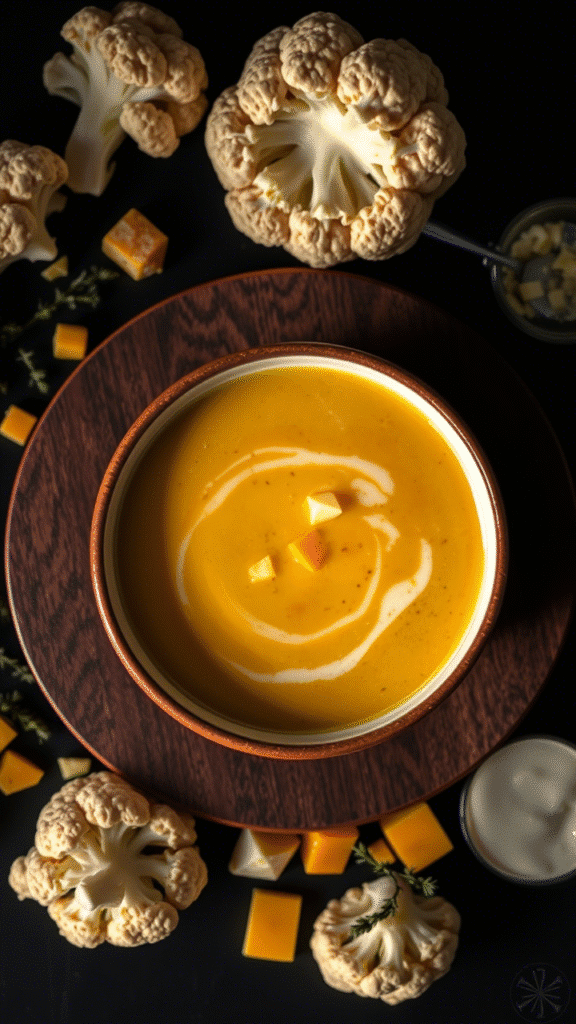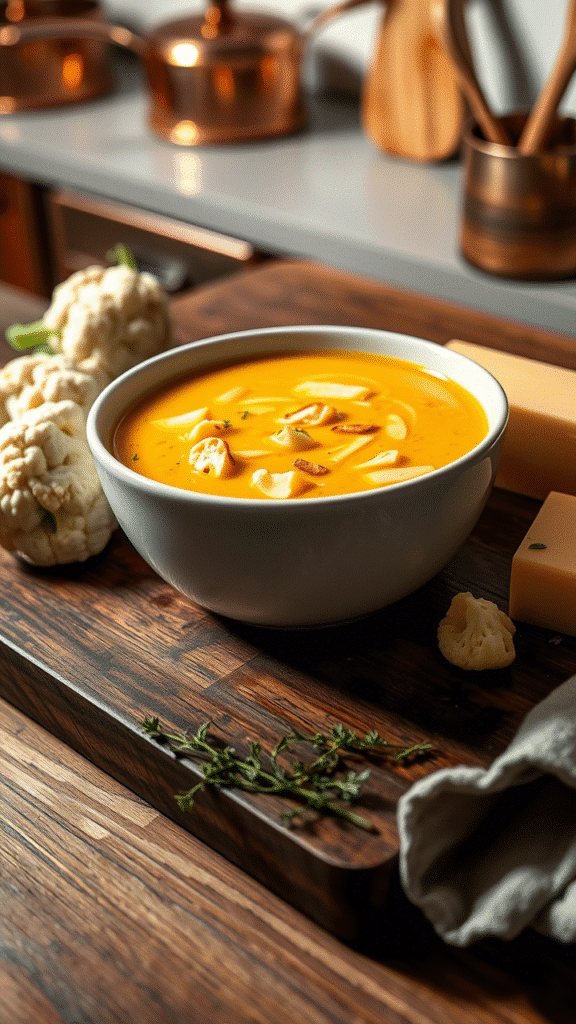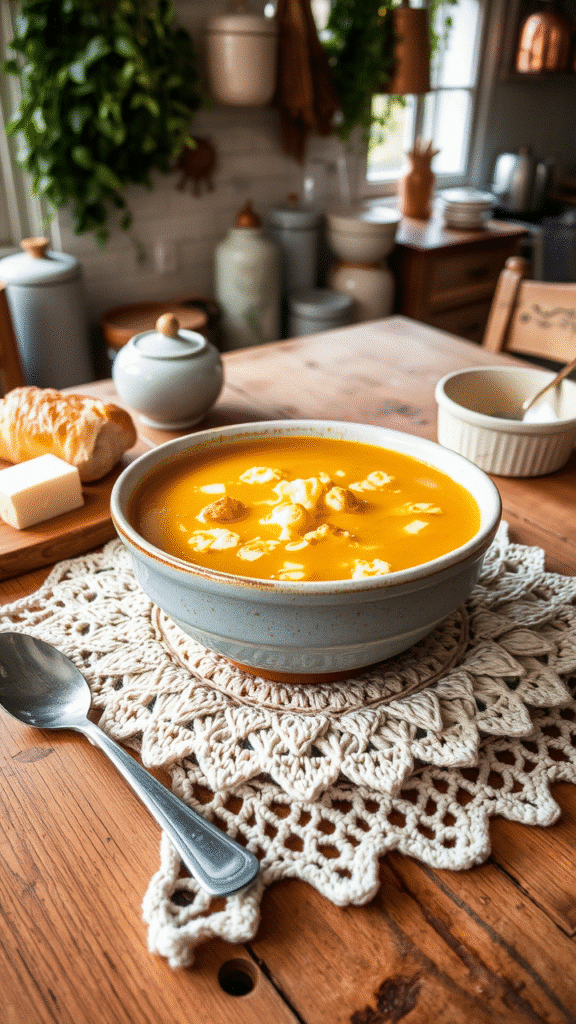Three years ago, I watched a veteran chef at Le Bernardin transform what most people consider a bland vegetable into something that made hardened line cooks stop mid-service to taste. That chef wasn’t using exotic ingredients or molecular gastronomy—he was simply roasting cauliflower until it reached that perfect balance between caramelized and tender. The transformation was nothing short of alchemical.
Roasted cauliflower cheddar soup represents the pinnacle of comfort food sophistication. Unlike its boiled counterpart, this version develops complex, nutty flavors through the Maillard reaction that occurs during high-heat roasting. The marriage of deeply caramelized cauliflower with sharp aged cheddar creates a symphony of umami that elevates this humble vegetable to restaurant-quality status.
What makes this soup truly special isn’t just the roasting technique—it’s the understanding of how different cooking methods affect flavor development. While most home cooks boil their cauliflower, losing precious flavor compounds to the cooking water, roasting concentrates these compounds while adding new ones through caramelization.
Ingredients & Substitutions
The foundation of exceptional roasted cauliflower cheddar soup begins with ingredient selection. Quality matters more than quantity, and understanding your ingredients allows for successful adaptations.
Primary Ingredients:
- 2 large heads cauliflower (about 3 pounds), cut into uniform florets
- 8 ounces sharp white cheddar, aged 12-18 months
- 4 ounces aged Gruyère cheese
- 4 cups high-quality chicken or vegetable stock
- 1 large yellow onion, diced
- 3 cloves garlic, minced
- 2 tablespoons olive oil
- 3 tablespoons unsalted butter
- 2 tablespoons all-purpose flour
- 1 cup heavy cream
- 1 teaspoon smoked paprika
- ½ teaspoon white pepper
- Salt to taste
- Fresh thyme sprigs
Substitution Strategies:
For the cauliflower, consistency in size matters more than perfection. Romanesco or white broccoli can substitute, though cooking times may vary slightly. Frozen cauliflower works in a pinch, but you’ll lose some of the caramelization potential due to higher water content.
Cheese selection dramatically impacts final flavor. Sharp cheddar provides tang and depth, while Gruyère adds nutty complexity. Aged gouda works beautifully as a Gruyère substitute, though it’ll create a slightly sweeter profile. For dietary restrictions, aged cashew cheese or nutritional yeast can provide umami depth, though the texture will differ.
Stock quality cannot be overstated. Homemade stock provides the best foundation, but high-quality store-bought options work well. Vegetable stock keeps the soup vegetarian, while chicken stock adds richness. Bone broth creates an exceptionally silky mouthfeel due to its gelatin content.
Heavy cream provides richness, but crème fraîche adds subtle tang that complements the aged cheese beautifully. For lighter versions, half-and-half works, though you’ll need to temper it carefully to prevent curdling.
Step-by-Step Instructions

Roasting the Cauliflower
Preheat your oven to 425°F. This temperature creates the ideal environment for caramelization without burning the florets’ delicate edges.
Cut cauliflower into uniform pieces, roughly 1-inch florets. Uniformity ensures even cooking—a fundamental principle that separates professional results from amateur attempts. Toss florets with olive oil, ensuring each piece is lightly coated but not drowning.
Season generously with salt and spread across two large sheet pans. Overcrowding prevents proper browning and creates steam instead of caramelization. Roast for 25-30 minutes, rotating pans halfway through.
The cauliflower is ready when edges are golden brown and florets pierce easily with a fork. Some darker spots are desirable—they add depth through concentrated flavor compounds.
Building the Soup Base
While cauliflower roasts, prepare your aromatic base. Heat butter in a heavy-bottomed pot over medium heat. Add diced onion and cook until translucent, about 5 minutes. The onion should soften without browning—we want sweetness, not caramelization here.
Add minced garlic and cook for 30 seconds until fragrant. Garlic burns quickly, so timing matters. Sprinkle flour over the mixture and cook for 2 minutes, stirring constantly. This creates a light roux that will thicken the soup without lumps.
Gradually add stock, whisking continuously to prevent lumps from forming. This technique, called “slurrying,” ensures smooth integration of the flour mixture.
Combining and Finishing
Add roasted cauliflower to the pot along with any accumulated pan juices. These fond particles contain concentrated flavor that would be wasted if left behind. Simmer for 15 minutes, allowing flavors to meld.
Remove from heat and blend to desired consistency. Immersion blenders offer control—you can achieve anything from chunky to perfectly smooth. For ultra-smooth texture, strain through a fine-mesh sieve after blending.
Return to low heat and gradually add cream, stirring constantly. Temperature control is critical—too much heat will cause the cream to curdle. Add cheese in small handfuls, allowing each addition to melt completely before adding more.
Season with smoked paprika, white pepper, and salt. Taste and adjust—the soup should be rich but not cloying, with distinct cauliflower and cheese flavors working in harmony.
Cooking Techniques & Science
The magic of roasted cauliflower cheddar soup lies in understanding the Maillard reaction. This complex chemical process occurs when proteins and sugars are exposed to high heat, creating hundreds of new flavor compounds. These compounds give roasted cauliflower its nutty, almost meaty depth that boiled cauliflower lacks entirely.

Temperature control throughout the process affects final texture dramatically. High heat during roasting concentrates flavors, while gentle heat during cheese incorporation prevents the proteins from seizing and creating a grainy texture. Professional kitchens maintain soup temperatures between 160-180°F during service for optimal consistency.
The science of cheese melting involves understanding protein structure. Aged cheeses like sharp cheddar contain less moisture and more concentrated proteins, which can become stringy if overheated. Adding cheese off the heat prevents this protein denaturation.
Stock selection impacts more than flavor—it affects mouthfeel through gelatin content. Homemade stock with natural gelatin creates a more luxurious texture than store-bought alternatives. This gelatin also helps bind the soup, reducing the need for excessive cream or flour.
Essential Equipment
A heavy-bottomed pot distributes heat evenly, preventing scorching during the simmering process. Cast iron or enameled steel work best for even heat distribution.
Sheet pans with low sides allow proper air circulation during roasting. Avoid using pans with high sides, which can trap steam and prevent browning.
An immersion blender offers the best control for texture. Traditional blenders work but require careful handling of hot liquids to prevent dangerous splattering.
Serving & Presentation
Proper serving elevates roasted cauliflower cheddar soup from humble comfort food to restaurant-worthy presentation. Serve in warmed bowls—cold porcelain will cool the soup too quickly, affecting both temperature and mouthfeel.
Garnish thoughtfully. A small mound of finely grated aged cheddar melts beautifully into the hot soup, adding visual appeal and extra richness. Toasted cauliflower florets, reserved from the roasting process, provide textural contrast.
Fresh thyme leaves add color and aromatic complexity. Avoid dried herbs for garnish—they lack the visual impact and fresh flavor needed for the final touch.
A drizzle of high-quality olive oil adds richness and creates an appealing surface sheen. Smoked paprika dusted lightly over the surface provides color contrast and subtle smokiness.
Pairing Suggestions
Roasted cauliflower cheddar soup pairs beautifully with crispy bread elements. Sourdough croutons, toasted with garlic and herbs, provide textural contrast. Grilled cheese sandwiches make an obvious but excellent pairing—consider using the same aged cheddar for consistency.
For wine pairings, choose something with enough acidity to cut through the richness. A crisp Sauvignon Blanc or unoaked Chardonnay works well. For red wine lovers, a light Pinot Noir won’t overpower the delicate cauliflower flavors.
Beer pairings should focus on styles that complement rather than compete. A Belgian wheat beer or German hefeweizen provides refreshing contrast, while a mild porter can echo the roasted flavors without overwhelming them.
Professional Tips & Troubleshooting
Temperature consistency throughout cooking prevents common problems. If your soup breaks or appears grainy, it’s likely due to overheating during cheese addition. Fix this by removing from heat, adding a splash of cold cream, and whisking vigorously.

Texture issues often stem from improper blending techniques. For ultra-smooth results, strain the soup through a fine-mesh sieve after blending. This extra step removes any remaining fiber and creates restaurant-quality smoothness.
Salt timing affects flavor development. Season the cauliflower before roasting to enhance caramelization, but reserve final seasoning until after cheese addition. Aged cheeses contribute significant saltiness that can throw off early seasoning attempts.
Storage and reheating require special attention. This soup keeps well for 3-4 days refrigerated but may separate slightly. Reheat gently over low heat, whisking frequently to restore smooth consistency. Never boil reheated soup containing dairy—it will separate irreversibly.
Variations & Creative Applications
Professional kitchens often create variations by adjusting the cheese profile. A combination of aged cheddar and blue cheese creates a more complex, tangy version. Adding cream cheese smooths out blue cheese’s intensity while maintaining flavor interest.
Roasted garlic variations involve roasting whole garlic heads alongside the cauliflower. The resulting sweet, caramelized garlic adds depth without sharpness. Squeeze roasted cloves directly into the soup during blending.
Spice variations can transform the soup’s character entirely. Curry powder added during the onion cooking stage creates an Indian-inspired version. Chipotle peppers in adobo sauce provide smoky heat that complements the roasted cauliflower beautifully.
For texture variations, reserve some roasted cauliflower florets and fold them in after blending. This creates a chunky version that showcases the ingredient while maintaining the soup’s creamy base.
Conclusion
Roasted cauliflower cheddar soup represents the intersection of technique and tradition, transforming simple ingredients through proper cooking methods. The key lies in understanding how roasting develops flavor, how cheese behaves under heat, and how proper seasoning brings everything together.
Master this recipe and you’ll understand fundamental principles that apply to countless other dishes. The roasting technique works for Brussels sprouts, broccoli, or root vegetables. The cheese incorporation method applies to any cream-based soup.
Remember that great cooking isn’t about following recipes blindly—it’s about understanding why each step matters. Taste constantly, adjust seasonings, and don’t be afraid to make the recipe your own. The best soups come from cooks who understand their ingredients and trust their palates.
Frequently Asked Questions?
Can I make this soup ahead of time? Absolutely. This soup actually improves after sitting overnight as flavors meld and develop. Store refrigerated for up to 4 days, but reheat gently over low heat while whisking frequently. The soup may separate slightly during storage, but proper reheating techniques will restore its smooth consistency.
Why does my soup sometimes turn out grainy?
Graininess typically results from overheating during cheese addition or using pre-shredded cheese. Pre-shredded cheeses contain anti-caking agents that prevent smooth melting. Always use freshly grated cheese and add it off the heat, whisking until completely melted before returning to gentle heat.
Can I freeze roasted cauliflower cheddar soup?
While possible, freezing affects texture due to the dairy content. The soup may separate when thawed and reheated. If you must freeze, do so for no more than 2 months and reheat very gently, whisking frequently. Consider freezing the base before adding cream and cheese, then finishing fresh when ready to serve.
What’s the best way to achieve restaurant-quality smoothness?
Use an immersion blender for initial blending, then strain through a fine-mesh sieve for ultimate smoothness. This two-step process removes any remaining fiber while creating silky texture. High-quality stock with natural gelatin content also contributes to luxurious mouthfeel.
How do I prevent the soup from being too thick or too thin?
Consistency depends on several factors: flour amount, stock concentration, and vegetable water content. If too thick, thin gradually with warm stock or cream. If too thin, create a small flour slurry (flour mixed with cold liquid) and whisk it in, then simmer until thickened. Remember that soup thickens as it cools, so aim for slightly thinner consistency while hot.

Veronica is a passionate food enthusiast with over three years of experience in exploring and writing about diverse cuisines. Her expertise lies in reviewing restaurants, sharing creative recipes, and discovering the latest food trends. As the voice behind FoodieRecap.com, Anju brings fresh perspectives and culinary insights to her audience.
